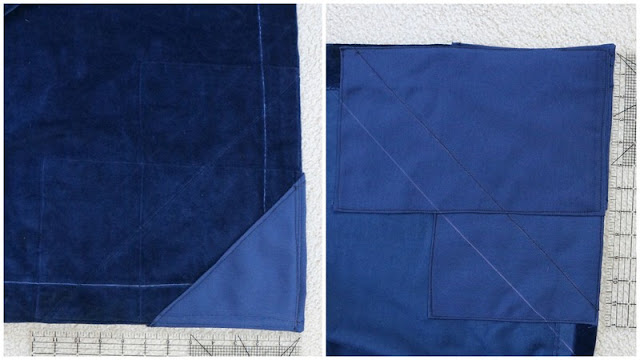 |
| Removing old headers and replace with new jute |
I received 10 drapes for my next set of repairs. I was asked to patch holes and deal with grommets that were pulling out of the drape headers. This was more of a challenge. I didn't want to sew over the metal grommets, wasn't sure how to shore up the weakness. In the end, I left many of the grommets as they were. Three drapes had more torn grommets than intact ones and the fabric around the others was tired. I sliced off the entire row of grommets for those drapes, ripped out the crumbling jute, and attached a brand new jute header. This required a full set of grommets to be installed. That seemed to be the safest route to fix the drape: removing all of the weakened fabric and jute, then add new. The drawback was that it removed three inches from the height of the drape and required a full set of grommets. Even though I was given the green light to do the modification, I wasn't sure if there'd be issues with a shorter drape. (Although I think they've been happy with the modification.)
My most recent delivery was 13 drapes. A few of these were ones I had deemed not bad enough to warrant a complete header replacement. I focused on fixing the grommets that were missing or in the process of ripping out of the drape.
After some research I decided that denim may be a good patch material. I wanted to cover both the torn jute and the threadbare velvet. Each patch was made of medium weight denim that I folded in on itself, then folded in half again (like bias tape). The patch was placed over the top of the drape, so that the denim covered both the front and the back. I made each patch about 3.5" wide, about 2.5" tall. This covered both the weak spot and the surrounding material so I could stitch the patch to an undamaged area. My thought was they can re-insert the grommet into the same place as before and the patch would hold together the damage and redistribute the stress along a larger area.
After some research I decided that denim may be a good patch material. I wanted to cover both the torn jute and the threadbare velvet. Each patch was made of medium weight denim that I folded in on itself, then folded in half again (like bias tape). The patch was placed over the top of the drape, so that the denim covered both the front and the back. I made each patch about 3.5" wide, about 2.5" tall. This covered both the weak spot and the surrounding material so I could stitch the patch to an undamaged area. My thought was they can re-insert the grommet into the same place as before and the patch would hold together the damage and redistribute the stress along a larger area.
It's hard to judge how this will work. Generally speaking with sewing, a patched area is never as strong as a whole piece of cloth. On the other hand, with good denim and new upholstery thread, I suspect these patches may be stronger than the surrounding area. My repair may end up moving the damage further down the header. I'll know if I find myself fixing ripped headers near these patches in the future.
The other patch was laughably overkill. But if it works, then I'm happy enough. This had the same sort of corner patch on the front, with the straight edges brought around to the back of the drape. The back consisted of two 7" x 12" pieces of denim, overlapped along the edge of the drape. (It's hard to see with the blue against blue.)
Both are designed for a corner grommet. The overkill patch could probably handle more than one grommet. I'll see what they look like in April.
One last note - the jute doesn't handle folding and unfolding very well. Along with the grommet damage, the headers were weakest where the drape has been folded. I think the constant use and storage of the drapes is causing some of the deterioration. I have been replacing old jute with new jute. It's inexpensive and easy to install if I'm replacing the whole header. But I wonder if I should consider something else that can handle the abuse these traveling Drapes endure. Something to think about for the next set of repairs.




Yikes......you are a wonder fixing all those curtains. A job well done by you, I would say.
ReplyDeleteI love the way you tackle a challenge! And I have been envisioning a velvet drapery to use as a sort of folding room divider - I want something dense enough to make people feel like it provides privacy but not so thick I can't keep it folded back 99% of the time. I really wasn't sure about velvet being feasible, but I can see it so clearly in my mind's eye. Now I wonder if I knew yours were velvet and I was just stealing your project!
ReplyDelete"Folding" is a bit misleading; I plan to hang this imaginary thing from a strong drapery rod.
Delete